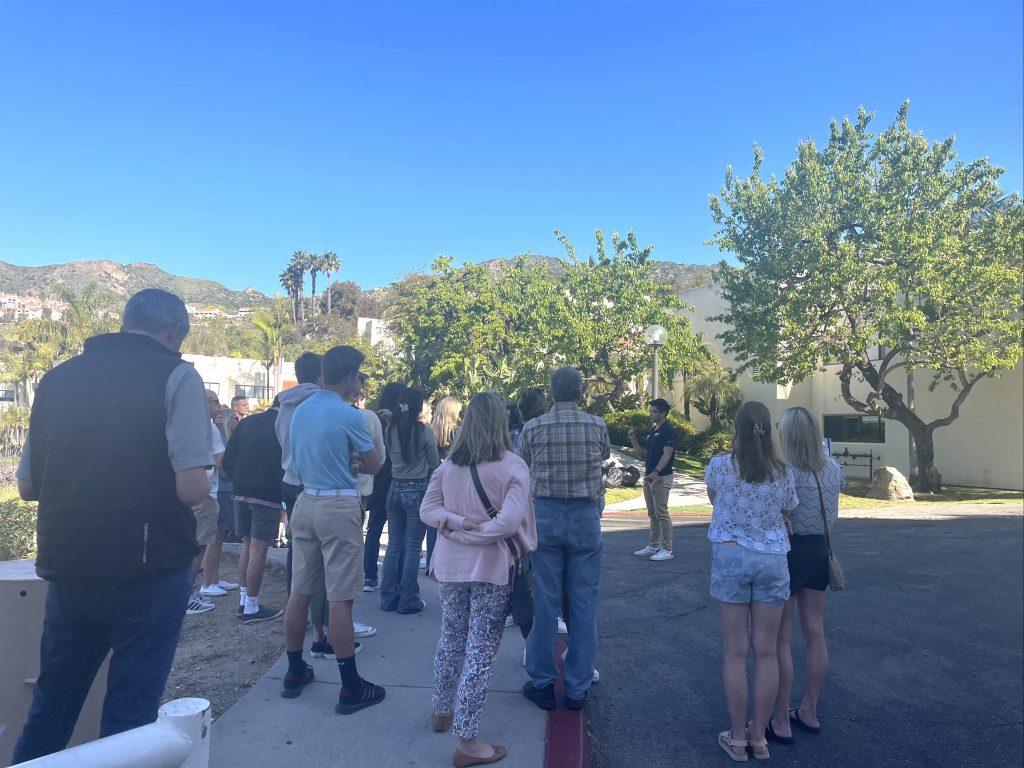Geneva Sovinec smiles outside her first-year housing dorm in March 2022. Despite the name of the building being the “Audene Merrill Connor House,” students typically just call the house “Connor.” Photo by Mary Elisabeth
The buildings on Pepperdine’s Malibu campus are adorned with plaques and dedication memos. However, these official names and histories often go unnoticed in the rush of the day-to-day activities that occupy Seaver undergraduate students’ schedules.
Names like “the Howard A. White Center,” named for Pepperdine’s fifth president and “Rockwell Towers Residential Halls,” named after the late son of Pepperdine benefactors Leon and Margaret Rockwell, are shortened to “the HAWC” and “Towers” and used in casual conversations with ease. These abbreviations and short hands exist for nearly every building on campus.
First-year tour guide Alex Paloglou said he learned the names of each building and the purpose it serves so he can educate prospective students and families as they tour campus.
“At the beginning of the last semester, I had to learn all the building names here on campus as a part of the tour guide job,” Paloglou said.
Alex Paloglou stands in front of a crowd of potential students and families on Pepperdine’s campus in March 2022. Paloglou has been a tour guide since September 2021 and typically leads one-to-two tours a week. Photo by Ella Coates
Paloglou said it was when he was learning all the names and backstories that he noticed the amount of students who were unaware of the proper names of buildings despite the places and signs on the outsides.
“I began to notice that a lot of students don’t really know all the names or the pronunciation of a lot of the different buildings on campus,” Paloglou said.
Many students refer to buildings such as the “Keck Science Center” and the “Cultural Arts Center” as the “KEC” and “CAC.” This trend could stem from the fact that Pepperdine references the classrooms found in the buildings as simply the first letter from each word followed by the room number on students schedules and campus maps.
First-year Joseph Macdaniel said he rarely ever uses the official names attached to the buildings.
“I don’t think I say a single full name for any building on campus on any given day,” Macdaniel said.
The building names vary between two and five words, which for many students think is too long, thus leading to the shorthand versions. These names are typically donor names like the Charles B. Thornton Administrative Center or the “TAC” which houses the administrative offices.
After his death in 1981 Flora Thornton, a member of the Pepperdine board of Regents and Charles Thornton’s wife, made a large donation to the university in his name.
Macdaniel said the short names are easier and more time efficient when just trying to identify the buildings in conversation.
“I shorten them for convenience,” Macdaniel said. “I also shorten others because I just don’t know what they officially are.”
First-year Geneva Sovinec said if a student were to use the official names in a conversation it would most likely catch her off-guard.
“If somebody were to come up to me and tell me the full name of a building, I would probably look at them and be very confused,” Sovinec said.
This trend extends past just classroom buildings, Sovinec said many students also shorten the names of first-year housing.
“It’s not just Connor, Crocker or E. Pen; those are shortened versions,” Sovinec said. “When in reality, they’re four words on the front of the building, but nobody refers to them as those official names.”
–––––––––––––––––––––
Follow the Graphic on Twitter: @PeppGraphic
Email Audrey Geib: audrey.geib@pepperdine.edu


